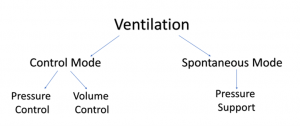The Ventilation “Family Tree”
If you imagine ventilation like a family tree, control and spontaneous are the main branches. Control modes are further split into two main sub-categories:
- Volume Control— the ventilator will deliver a set volume of air to the lungs
- Pressure Control—the ventilator will deliver a set pressure of air to the lungs

Regardless of how the control breaths are labelled or described, keep in mind that control breaths are set and delivered by the medical provider on the ventilator, and either category gives you the same outcome—fully “controlled” breaths that a patient must take. Essentially, every controlled or mandatory breath—regardless of whether it is considered a volume or pressure breath—is still describing the same thing. Air is being pushed into the lungs by a machine. This designation of “pressure” or “volume” refers to how the breath is described via settings on the ventilator. Both pressure and volume modes do the exact same thing: push air into the lungs according to the clinician’s chosen settings and then let the lungs exhale passively.
Spontaneous breaths, or assisted breaths a patient chooses to take, are overwhelmingly delivered via pressure support ventilation.
Key Takeaway
Media Attributions
- Ventilation Family Tree © Melody Bishop is licensed under a CC0 (Creative Commons Zero) license

